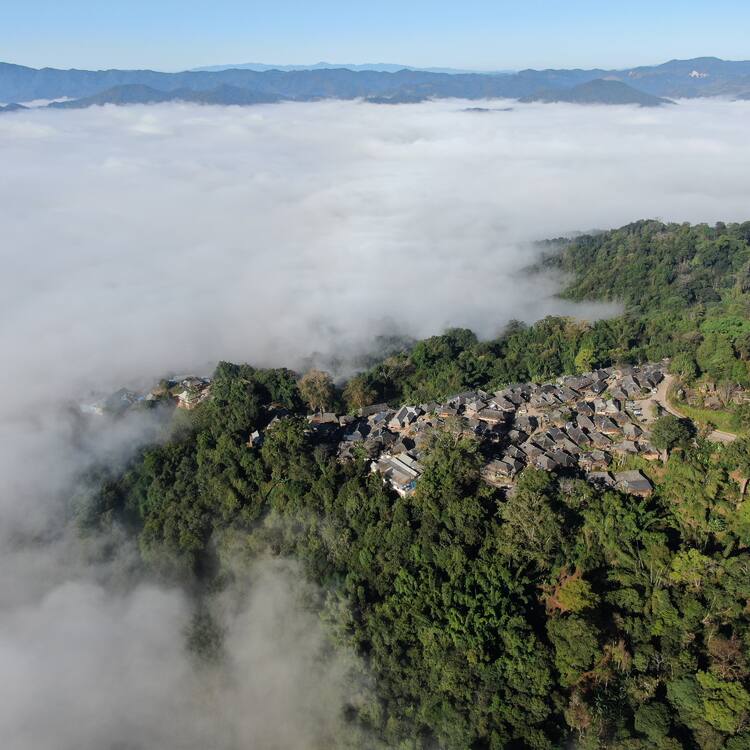Cultural Landscape of Old Tea Forests of the Jingmai Mountain in Pu’er
Cultural Landscape of Old Tea Forests of the Jingmai Mountain in Pu’er
Description is available under license CC-BY-SA IGO 3.0
Paysage culturel des forêts anciennes de théiers de la montagne Jingmai à Pu’er
Description is available under license CC-BY-SA IGO 3.0
المنظر الطبيعي الثقافي لغابات الشاي القديمة على جبل جينغماي في بوير
source: UNESCO/CPE
Description is available under license CC-BY-SA IGO 3.0
普洱景迈山古茶林文化景观
source: UNESCO/CPE
Description is available under license CC-BY-SA IGO 3.0
Культурный ландшафт древних чайных лесов горы Цзинмай в Пуэре
source: UNESCO/CPE
Description is available under license CC-BY-SA IGO 3.0
Paisaje cultural de los antiguos bosques de árboles del té de la montaña Jingmai en Pu'er
source: UNESCO/CPE
Description is available under license CC-BY-SA IGO 3.0
Outstanding Universal Value
Brief synthesis
The Cultural Landscape of Old Tea Forests of the Jingmai Mountain in Pu’er is located in Huimin Town, Pu’er City, Yunnan Province, in southwestern China. This organically evolved cultural landscape consists of a tea production area of old tea groves, tea plantations, forests, and traditional villages on Jingmai Mountain. This land-use system has been developed over a thousand years by the Blang and Dai peoples following traditional practices that date back to the 10th century. The traditional understorey cultivation of old tea trees is a method that responds to the specific conditions of the mountain ecosystem and subtropical monsoon climate combined with a particular governance system maintained by the Indigenous communities residing in this area. Traditional ceremonies and festivities related to the Tea Ancestor belief that special spirits live in the tea plantations, local fauna, and flora are at the core of this cultural tradition.
Criterion (iii): The Cultural Landscape of Old Tea Forests of the Jingmai Mountain in Pu’er represents an exceptional testimony of the understorey tea cultivation traditions that enabled the development of a complementary spatial distribution of different land uses providing ecosystems and microclimates that support both the cultivation of old tea forests and the well-being of communities residing in this organically evolved cultural landscape. Blang and Dai peoples sustained these traditions for over thousand years by following a tripartite social governance system of tribe-government-religion that, based on the Tea Ancestor belief, has protected the natural resources and preserved the old tea forests. Traditional practices follow careful considerations of the mountain climate, topographic features, and local flora and fauna, demonstrating important local and traditional knowledge that safeguards cultural and biological diversity.
Criterion (v): The Cultural Landscape of Old Tea Forests of the Jingmai Mountain in Pu’er is an outstanding example of a sustainable land-use system based on a combination of horizontal and vertical land-use patterns. This land-use system permits the complementary use of natural resources in the mountainous environment of Jingmai Mountain and represents an exceptional example of a human interaction by Blang and Dai peoples with a challenging environment that is vulnerable to negative impacts of modernisation, urban development, and climate change. The location and layout of the traditional villages and the style of residential buildings represent the cultures and traditional knowledge of Blang and Dai peoples.
Integrity
The integrity of the property is based on the preservation of the social relationships and ecological interdependencies between the climate, the topographic features, and the cultural practices of the Blang and Dai peoples on Jingmai Mountain. All the key attributes are included within the boundaries, including the old tea forests, the protective partition forests, the tea plantations, the traditional villages, the traditional knowledge and governance system associated with the tea culture, and the cultural and spiritual expressions associated with that culture such as festivals, religious ceremonies, and traditional dances. The boundaries also encompass the immediate setting, thus reinforcing the integrity of the cultural landscape.
Traditional villages within the property are currently under pressure from urban development and could be negatively affected in the future by increased tourism development.
Authenticity
The authenticity of the property is based on the location, use, and function of the old tea forests; the location, form, and design of the traditional villages; the form and design of the traditional houses; and the form, function, and substance of the land-use system, including the horizontal and vertical patterns. It is also based on the continuity of traditions associated with the tea culture on Jingmai Mountain.
Sources of information include the continuous presence of the landscape elements and the continuous upkeep of the land-use system, the cultural practices associated with understorey tea cultivation, legends, oral history, traditional knowledge and the related belief and governance systems.
Protection and management requirements
The property is protected at the highest level by national laws for cultural property, ecology, environment, forests, animal and plant species, and intangible cultural heritage. In addition, the local authorities have prepared and announced laws and regulations tailored to its protection. The buffer zone adds a layer of protection to the property, containing forests, farms, and villages where development is regulated.
A protection and management system that involves all stakeholders, including the local authorities, villagers, and professional institutions, has been developed. This protection and management system, along with the tribe-government-religion tripartite social governance arrangement and relevant planning documents such as the Conservation Plan for the Cultural Heritage of Old Tea Plantations of Jingmai Mountain as a National Priority Protected Site (2017-2035), the Plan for Villages in the Jingmai Mountain (2019-2040), and the Conservation Management Plan for the Cultural Landscape of Old Tea Forests of the Jingmai Mountain in Pu’er (2020-2040) provide a robust mechanism for the conservation and management of the property and the sustainable development of its communities. The old tea forests, protective partition forests, villages, and entire environment of the property are the subjects of comprehensive monitoring, and a disaster preparedness mechanism has been developed.
